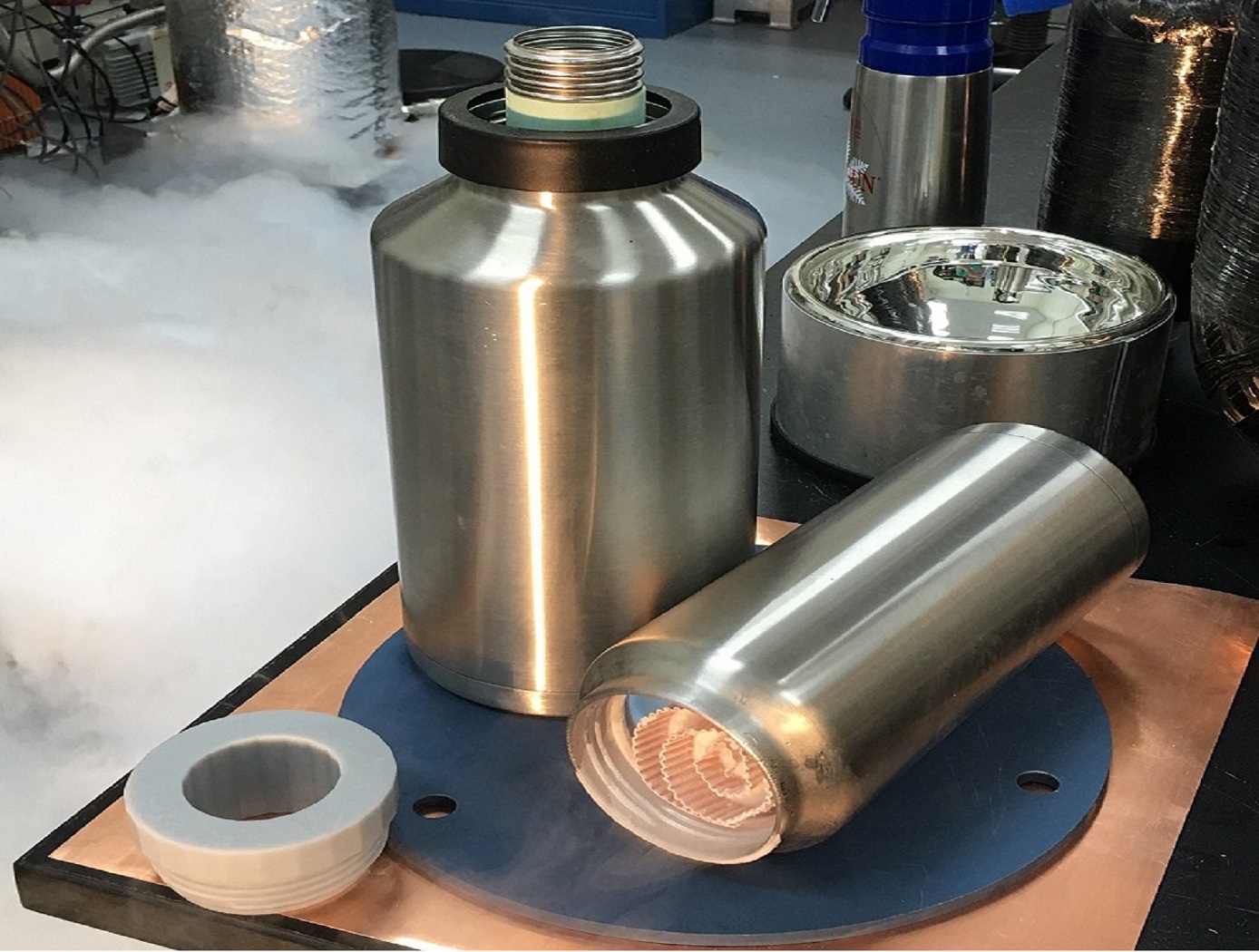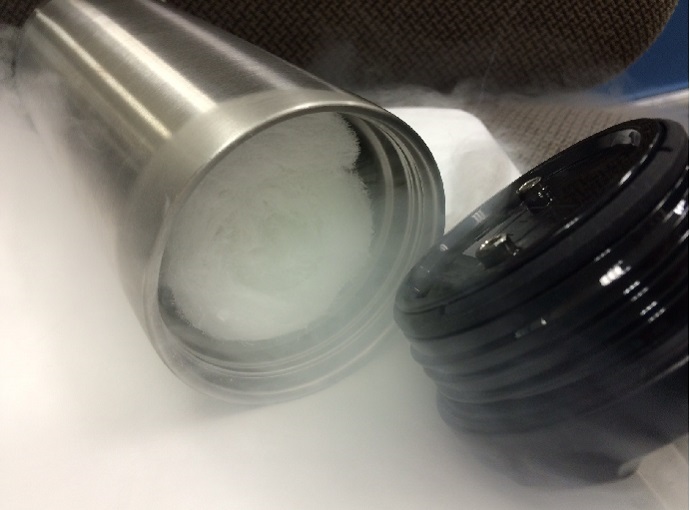Cryogenic Flux Capacitor
Power Generation and Storage
Cryogenic Flux Capacitor (KSC-TOPS-62)
A Device for Solid-State Storage and On-Demand Distribution of Cryogenic Fluid Commodities
Overview
NASA Kennedy Space Center seeks partners interested in the commercial application of the Cryogenic Flux Capacitor (CFC). This new technology capitalizes on the energy storage capacity of liquefied gasses. By exploiting a unique attribute of nano-porous materials, aerogel in this case, fluid commodities such as oxygen, hydrogen, methane, etc. can be stored in a molecular surface-adsorbed state. This cryogenic fluid can be stored at low to moderate pressure densities, on par with liquid, and then quickly converted to a gas, when the need arises. This solution reduces both safety-related logistics issues and the limitations of complex storage systems. Currently, high pressured gasses are stored in vessels with heavy thick walls that require constant pressurization and complex storage systems to limit boil-off. These systems are not well suited to overly dynamic situations where the tank orientation can change suddenly. NASA's CFC address all of the aforementioned issues, simplifying current operations and opening the possibilities for new applications and new markets from cryogenic liquid.
The Technology
Storage and transfer of fluid commodities such as oxygen, hydrogen, natural gas, nitrogen, argon, etc. is an absolute necessity in virtually every industry on Earth. These fluids are typically contained in one of two ways; as low pressure, cryogenic liquids, or as a high pressure gases. Energy storage is not useful unless the energy can be practically obtained ("un-stored") as needed. Here the goal is to store as many fluid molecules as possible in the smallest, lightest weight volume possible; and to supply ("un-store") those molecules on demand as needed in the end-use application. The CFC concept addresses this dual storage/usage problem with an elegant charging/discharging design approach.
The CFC's packaging is ingeniously designed, tightly packing aerogel composite materials within a container allows for a greater amount of storage media to be packed densely and strategically. An integrated conductive membrane also acts as a highly effective heat exchanger that easily distributes heat through the entire container to discharge the CFC quickly, it can also be interfaced to a cooling source for convenient system charging; this feature also allows the fluid to easily saturate the container for fast charging. Additionally, the unit can be charged either with cryogenic liquid or from an ambient temperature gas supply, depending on the desired manner of refrigeration. Finally, the heater integration system offers two promising methods, both of which have been fabricated and tested, to evenly distribute heat throughout the entire core, both axially and radially.
NASA engineers also applied the CFC to a Cryogenic Oxygen Storage Module to store oxygen in solid-state form and deliver it as a gas to an end-use environmental control and/or life support system. The Module can scrub out nuisance or containment gases such as carbon dioxide and/or water vapor in conjunction with supplying oxygen, forming a synergistic system when used in a closed-loop application. The combination of these capabilities to work simultaneously may allow for reduced system volume, mass, complexity, and cost of a breathing device.


Benefits
- Compact fuel storage
- Light weight
- Low to moderate storage pressures
- Fast charge-up times
- On-demand, fast discharges
Applications
- Spacecraft
- Cubesats
- Aircraft
- Transportation
- Fuel Cells
- Medical
- Breathers
Technology Details
Power Generation and Storage
KSC-TOPS-62
KSC-14075
PRELIMINARY EXPERIMENTAL STUDIES INTO THE STORAGE CAPACITY OF CRYOGENIC HYDROGEN IN AEROGEL BLANKET MATERIALS
Cryogenic Engineering Conference 2023
|
Tags:
|
|
|
Related Links:
|
Similar Results
Cryogenic Oxygen Storage Modules COSM
The COSM employs NASA's Cryogenic Flux Capacitor core to store liquid oxygen (at 90 K) in silica aerogel material at ambient pressure, and then discharges cold oxygen gas into an in-line flow loop in response to heat input. If the composition of the incoming effluent stream contains gases with condensation or freezing points above the 90 K oxygen storage temperature--such as carbon dioxide or water vapor--these gasses can be removed from the stream as it moves through the COSM. The current COSM is sized to be wearable on the person but can be easily scaled to much larger sizes and various geometries.
COSM is designed with a long "cold path" which provides for greater residence times which increase the probability that condensable/freezable gases will be trapped in the COSM. Also, the longer the cold path, the longer the time a COSM can be used prior to the oxygen being depleted and the scrubbed gasses liberated. Two COSM geometries have been designed, built, and tested-a round spiral and a prismatic serpentine--to achieve long cold paths, and intrinsic vapor cooling to manage heat loads.

Liquid Sorbent Carbon Dioxide Removal System
NASA's Liquid Sorbent Carbon Dioxide Removal System was designed as an alternative to the current CO2 removal technology used on the International Space Station (ISS), which uses solid zeolite media that is prone to dusting, has a low absorption capacity, and requires high regeneration temperatures and frequent maintenance. Motivated by CO2 removal systems on submarines, NASA innovators began investigating the use of liquid sorbents. Liquid sorbents have a capacity four times greater than solid zeolites, require low regeneration temperature, and need fewer unreliable moving mechanical parts than solid based systems. While submarine CO2 scrubbers spray an adsorbing chemical directly into the air stream and allow the liquid to settle, NASA's new system uses a capillary driven 3D printed microchannel direct air/liquid contactor in a closed loop system. The Liquid Sorbent Carbon Dioxide Removal System is robust and reliable, while being low in weight, volume, and power requirements. The system is capable of reaching equilibrium when the liquid sorbent surface is being regenerated at a rate equal to the rate of absorption into the liquid.

Air Revitalization for Vacuum Environments
The NASA life support system uses a regenerable vacuum swing adsorption process, known as Sorbent-Based Air Revitalization (SBAR), to separate water and carbon dioxide for disposal. The SBAR system is an adsorbent-based swing bed system that has been optimized to provide both humidity and carbon dioxide control for a spacecraft cabin atmosphere.
The system comprises composite silica gel and zeolite-packed beds for adsorption and a bypass system for flow control. Under normal operating conditions, the disposal system would require a high-quality vacuum environment to operate. Improvements to the SBAR system include an enhanced inherent capacitance that extends the operation time within a non-vacuum environment for up to 4.5 hours. Flight time can be further expanded with multiple SBAR systems to allow for system regeneration. By scheduling periodic thermal regenerations—nominally during sleep periods—the SBAR technology may be suitable for missions of unlimited duration.

Modular Container System Preserves Sample Integrity
The Astromaterials Acquisition and Curation Office (AACO) at NASA Johnson Space Center currently curates 500 milligrams of the regolith sample from the Asteroid Ryugu that was collected by the Japan Aerospace and Exploration Agency’s Hayabusa II spacecraft and returned to Earth in 2021. In September 2023, NASA’s OSIRIS-REx spacecraft returned 70 grams of regolith collected from the surface of Asteroid Bennu. These astromaterial sample collections are stored and handled in gloveboxes and desiccators that are continuously purged with ultrapure nitrogen in order to minimize contamination and alteration of extraterrestrial samples from terrestrial environments.
For collaborative astromaterial sample research conducted outside of the AACO, a need emerged for a sample container system suitable for global transport, capable of maintaining the same low-oxygen envi-ronment as laboratory gloveboxes. Thus, the MCS was developed. MSC’s of different sizes (2, 4, and 8-inch sample container models) have been developed to store contact pads and bulk samples from NASA missions, including the OSIRIS-REx Asteroid Bennu mission.
MCS’s are designed with seal profiles to prevent oxygen from seeping into the sample container. Additionally, the MCS uses a sample container form-factor that optimizes favorable nitrogen to oxygen gas ratios. The final prototypes were tested and verified using optochemical sensors to measure trace oxygen levels within the sealed containers.
The Modular Container System (MCS) could fill a critical gap in the existing high-purity logistics and storage market in its ability to provide a passively maintained, verifiable, multi-year, glovebox-level low-oxygen environment in a portable robust form-factor. Although this technology was originally developed for astromaterial transport and storage, commercial applications may also exist in biopharmaceutical/ bio-banking, microelectronics/ semiconductor, and other industries.

3D-Printed Injector for Cryogenic Fluid Management
NASA's TVS Augmented Injector includes an internal heat exchanger, a fluid injector spray head, and an external surface condensation heat exchanger - all combined with multiple intertwined flow paths containing liquid, two-phase, and gaseous working fluid. The TVS provides a source of coolant to the injector, which chills the incoming fluid flow. This cooled flow promotes condensation of the tank ullage dropping pressure and maintains incoming fluid flow. The system eliminates the potential for a stalled fill condition and reduces tank pressure during cryogenic fluid transfer. During fill operations, the tank vent can be closed early in the process before fluid is introduced, and, in some cases, the tank vent may not even need to be opened. Furthermore, the TVS Augmented Injector can remove sufficient thermal energy to reach a 100% liquid level in the receiver tank. A cryo-cooler can be used in place the TVS flow circuit for a zero-loss system. The TVS Augmented Injector couples internal fluid flow cooling and external surface ullage gas condensation into a single, compact package that can be mounted to small tank flanges for minimal impact insertion into any vessel. The injector is printed as one part using additive manufacturing, resulting in part count reduction, improved reproducibility, shorter lead times, and reduced cost compared to conventional approaches.
The injector may be of particular interest in applications where cryogenic fluid is expensive, fluid loss through vents is problematic, and/or achieving high filling levels would be helpful. The injector can benefit typical cryogenic fluid transfer between containers or, alternatively, can serve as a tank pressure control device for long-term storage using a fluid recirculation system that pumps fluid through the injector and sprays cooled liquid back into the tank. Additionally, where ISRU processes are employed, the injector can be used to liquefy incoming propellant streams.



